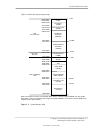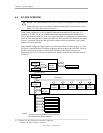
Technical Reference Guide
RATION
at
NT), and FRAME signals are used
by PCI bus masters for gaining access to the PCI bus. When a PCI device needs access to the PCI
bus (and does not already own it), the PCI device asserts it’s REQn signal to the PCI bus arbiter (a
ler component). If the bus is available, the arbiter asserts the GNTn
signal to the requesting device, which then asserts FRAME and conducts the address phase of the
e 4-3. PCI Bus Mastering Devices
Table 4-3.
4.2.2 PCI BUS MASTER ARBIT
The PCI bus supports a bus master/target arbitration scheme. A bus master is a device that has
been granted control of the bus for the purpose of initiating a transaction. A target is a device th
is the recipient of a transaction. The Request (REQ), Grant (G
function of the system control
transaction with a target. If the PCI device already owns the bus, a request is not needed and the
device can simply assert FRAME and conduct the transaction. Table 4-3 shows the grant and
request signals assignments for the devices on the PCI bus.
Tabl
PCI Bus Mastering Devices
REQ/GNT Line Device
REQ0/GNT0 PCI Connector Slot 1
REQ1/GNT1 PCI Connector Slot 2
REQ2/GNT2 PCI Connector Slot 3 [1]
REQ3/GNT3 PCI Connector Slot 4 [2]
REQ4/GNT4 PCI Connector Slot 5 [2]
GREQ/GGNT AGP Slot
NOTE:
urable Minitower models only.
wer models only
m
ecified by the PCI specification. The bus parking policy allows for the current PCI bus owner
idge) to maintain ownership of the bus as long as no request is asserted
a t most CPU-to-DRAM and AGP-to-DRAM accesses can occur
oncurrently with PCI traffic, therefore reducing the need for the Host/PCI bridge to compete for
[1] Desktop and Config
[2] Configurable minito
CI bus arbitration is based on a round-robin scheme that complies with the fairness algorithP
sp
(excepting the PCI/ISA br
by nother agent. Note tha
c
PCI bus ownership.
Compaq Evo and Workstation Personal Computers
Featuring the Intel Pentium 4 Processor
Second Edition - January 2003
4-7


















